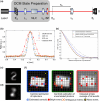Quantum super-resolution imaging: a review and perspective
- PMID: 40470088
- PMCID: PMC12133316
- DOI: 10.1515/nanoph-2024-0597
Quantum super-resolution imaging: a review and perspective
Abstract
Quantum super-resolution imaging provides a nonlabeling method to surpass the diffraction limit of imaging systems. This technique relies on measurement of the second-order correlation function and usually employs spatially entangled photon sources. We introduce recent methods that achieve spatial resolution enhancement through quantum approaches, particularly the imaging techniques utilizing biphoton states. The fundamental mechanisms are discussed in detail to explain why biphoton states enable super-resolution. Additionally, we introduce multiple algorithms that extract the correlation function from the readings of two-dimensional detectors. Several cases are reviewed to evaluate the advantages and prospects of quantum imaging, along with a discussion of practical developments and potential applications.
Keywords: quantum entanglement; quantum imaging; super-resolution imaging.
© 2025 the author(s), published by De Gruyter, Berlin/Boston.
Conflict of interest statement
Conflict of interest: Authors state no conflicts of interest.
Figures





Similar articles
-
Pixel super-resolution with spatially entangled photons.Nat Commun. 2022 Jun 22;13(1):3566. doi: 10.1038/s41467-022-31052-6. Nat Commun. 2022. PMID: 35732642 Free PMC article.
-
Quantum microscopy of cells at the Heisenberg limit.Nat Commun. 2023 Apr 28;14(1):2441. doi: 10.1038/s41467-023-38191-4. Nat Commun. 2023. PMID: 37117176 Free PMC article.
-
Machine learning assisted quantum super-resolution microscopy.Nat Commun. 2023 Aug 10;14(1):4828. doi: 10.1038/s41467-023-40506-4. Nat Commun. 2023. PMID: 37563106 Free PMC article.
-
[Comparison and progress review of various super-resolution fluorescence imaging techniques].Se Pu. 2021 Oct;39(10):1055-1064. doi: 10.3724/SP.J.1123.2021.06015. Se Pu. 2021. PMID: 34505427 Free PMC article. Review. Chinese.
-
Fluorescent Carbon Dots for Super-Resolution Microscopy.Materials (Basel). 2023 Jan 17;16(3):890. doi: 10.3390/ma16030890. Materials (Basel). 2023. PMID: 36769896 Free PMC article. Review.
Cited by
-
Quantum light: creation, integration, and applications.Nanophotonics. 2025 May 22;14(11):1683-1686. doi: 10.1515/nanoph-2025-0180. eCollection 2025 Jun. Nanophotonics. 2025. PMID: 40470090 Free PMC article.
-
Application of quantum imaging in biology.Biomed Opt Express. 2025 Jul 23;16(8):3349-3377. doi: 10.1364/BOE.566801. eCollection 2025 Aug 1. Biomed Opt Express. 2025. PMID: 40809988 Free PMC article. Review.
References
-
- Gramotnev D. K., Bozhevolnyi S. I. Plasmonics beyond the diffraction limit. Nat. Photonics . 2010;4(2):83–91. doi: 10.1038/nphoton.2009.282. - DOI
Publication types
LinkOut - more resources
Full Text Sources
